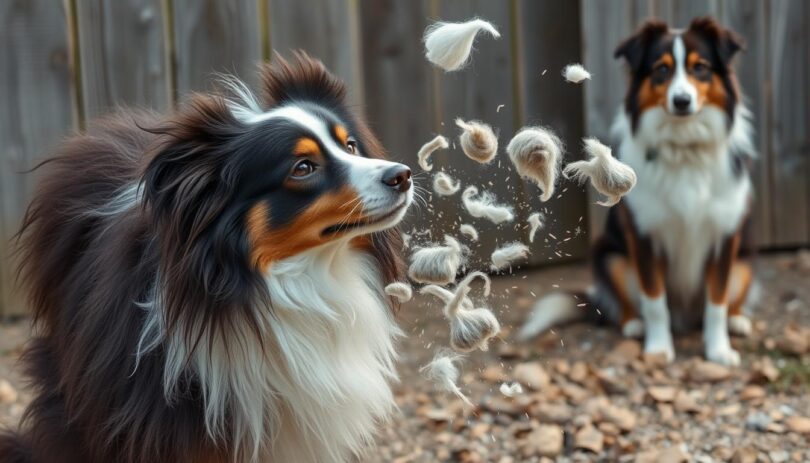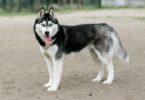Picture this: you’re curled up with your energetic, loyal companion, their striking blue eyes and silky fur making them the star of every walk. But then you spot it—a fresh layer of hair on your couch, clothes, and floors. If this scene feels familiar, you’re not alone. Many owners adore these intelligent dogs but are surprised by their furry reality.
Yes, these medium-sized herding dogs shed year-round. Their thick double coat—a soft underlayer and weather-resistant topcoat—means loose fur is part of daily life. Seasonal changes bring heavier “coat blows,” especially in spring and fall. Understanding this cycle helps manage expectations and routines.
This guide explores why shedding happens and how to reduce its impact. You’ll learn grooming techniques tailored to their unique coat, tools that make a difference, and strategies for keeping your home fur-free. From brushing schedules to diet tips, practical solutions await.
While their vibrant appearance might suggest low maintenance, regular care is essential. By embracing their natural shedding patterns, you can enjoy a cleaner space and a healthier, happier companion. Let’s dive into the details.
Overview of Australian Shepherd Shedding
Managing loose fur is part of life with these intelligent herding companions. Their double-layered coat—a soft undercoat beneath a tougher outer layer—creates continuous shedding. While the topcoat releases hairs gradually, the dense underlayer sheds heavily during seasonal transitions, leaving tufts around your home.
Research shows this breed sheds moderately year-round, peaking in spring and fall. During these “coat blows,” the undercoat detaches in clumps to adjust to temperature changes. Regular grooming isn’t optional—it’s essential for controlling loose hair and maintaining skin health.
Brushing sessions three times weekly with tools like undercoat rakes or deshedding combs make a visible difference. These practices trap loose fur before it spreads, reducing cleanup time. For pet owners, establishing this routine strengthens the bond while keeping living spaces tidier.
Though no dog is truly hypoallergenic, consistent care minimizes shedding’s impact. Combining proper grooming with vacuuming strategies creates a balanced approach. Understanding this natural process helps owners support their shepherd’s comfort and household cleanliness simultaneously.
Understanding the Double Coat: Undercoat and Outer Coat
Imagine layers working together like nature’s thermostat. The Australian Shepherd’s coat consists of two distinct layers: a fluffy undercoat and a sleeker outer layer. This design isn’t accidental—it evolved to protect against harsh weather while regulating body temperature.
Coat Structure and Natural Function
The soft undercoat acts like insulation, trapping warmth during winter. Meanwhile, the outer guard hairs repel rain and block UV rays. These layers work in harmony—like a built-in climate control system—to keep your dog comfortable year-round.
Why Double Coats Lead to More Shedding
Twice the layers mean twice the shedding. The undercoat sheds heavily during seasonal shifts as temperatures change. This process, called “blowing coat,” releases clumps of fur to make way for new growth. Regular brushing with an undercoat rake captures loose strands before they spread.
Outer coat hairs are longer and coarser, shedding gradually. The undercoat’s finer hairs create that signature “fluff” around your home. Brushing three times weekly with a slicker brush manages both layers effectively, similar to other double-coated breeds. Consistent care keeps shedding predictable and your living space cleaner.
Do Australian Shepherds Shed: Facts and Figures
Ever wonder how much fur these energetic dogs leave behind? Studies show they shed up to 20% more hair during peak seasons compared to other double-coated breeds. Spring and fall are the primary shedding seasons, with fur loss intensifying for 4–6 weeks as temperatures shift.
German Shepherds and Golden Retrievers shed similarly, but breeds like Huskies surpass them in sheer volume. A typical Aussie produces 1–2 cups of loose hair weekly during heavy shedding seasons. Owners often joke about “shepherds shed” becoming a permanent decor theme—lighthearted proof of their pet’s productivity.
Experts note predictable patterns: spring shedding removes winter insulation, while fall prepares for colder months. Brushing 4–5 times weekly during these periods captures 60% of loose strands before they spread. While no breed is fur-free, understanding these cycles helps manage expectations and routines.
Seasonal Shedding Patterns: Spring and Fall Blowouts
Seasonal shifts bring predictable fur cycles for double-coated breeds. Temperature changes signal the body to adjust insulation, triggering extensive coat renewal twice yearly. These transitions—known as “blowouts”—require tailored grooming strategies to manage efficiently.
Spring: Losing the Winter Undercoat
As daylight increases, the dense winter undercoat loosens in clumps. This spring shedding phase lasts 4–6 weeks, clearing insulation no longer needed for warmer months. Brushing becomes critical during this period—daily sessions with an undercoat rake prevent matting and reduce airborne fur.
Fall: Transitioning to a Thicker Winter Coat
Cooler autumn temperatures prompt the summer coat to shed, making room for a denser winter layer. Unlike spring’s rapid undercoat loss, fall shedding occurs gradually over 3–5 weeks. Consistent brushing with a deshedding tool captures loose guard hairs before they settle on furniture.
Tracking these annual patterns helps owners optimize grooming schedules. Increasing brush frequency during peak months minimizes fur accumulation. While shedding can’t be stopped, understanding its purpose—temperature regulation—makes maintenance feel purposeful rather than frustrating.
Effective Grooming Techniques to Reduce Shedding
When your furry friend leaves a trail of hair wherever they go, a solid grooming routine becomes your best ally. Regular care minimizes loose fur and keeps shedding under control. The right tools and techniques can transform messy shedding into manageable maintenance.
Brushing and De-Shedding Tools
Brushing three times weekly with specialized tools makes a visible difference. Slicker brushes detangle outer coats, while undercoat rakes remove hidden loose fur. For heavy shedding phases, deshedding tools with stainless steel teeth pull trapped hairs without irritating skin.
Start at the neck and brush downward in sections, following hair growth. Focus on dense areas like the chest and hindquarters. Sessions should last 10–15 minutes to cover all layers thoroughly. This spreads natural oils, preventing dryness that worsens shedding.
Bathing and Shampooing Best Practices
Bathe your pet every 6–8 weeks using oatmeal-based or moisturizing shampoo. These formulas cleanse without stripping essential oils. Avoid human shampoos—their pH levels can cause skin irritation and increase shedding.
After rinsing, towel-dry gently and use a high-velocity dryer to remove loose undercoat. Finish with a quick brush to catch remaining hairs. Pairing baths with consistent brushing routines reduces shedding by 40–50%, keeping coats healthy and homes cleaner.
Home Care Tips for Managing Dog Hair Everywhere
Ever found yourself battling tumbleweeds of pet hair? Strategic home care transforms chaos into manageable routines. For owners of active pups, controlling loose fur requires smart tools and daily habits that blend seamlessly into busy lives.
Vacuuming, Lint Rollers, and Furniture Protection
Robot vacuums work overtime for you. These devices clean floors daily, targeting hair hotspots like under furniture and near entryways. Pair them with handheld vacuums for stairs and car interiors—a quick 5-minute session prevents buildup.
Lint rollers become pocket-sized allies. Keep one in your car, desk, and near doorways for instant clothing touch-ups. For upholstery, rubber gloves or damp sponges lift embedded hairs faster than traditional brushes.
Protect sofas and beds with washable covers. Choose tight-weave fabrics that repel fur, rotating them weekly. Training pets to use designated blankets creates easy-to-clean zones while preserving your furniture’s appearance.
Regular care extends beyond cleanliness. Reducing airborne fur minimizes allergens, creating healthier spaces for families. For comprehensive coat health strategies, combine these home tactics with proper nutrition and grooming routines.
Diet, Supplements, and Skin Health for a Shiny Coat
What your dog eats directly impacts the fur covering your floors. Nutrition fuels coat quality and shedding patterns. A balanced regimen rich in essential nutrients strengthens hair follicles and maintains skin elasticity, reducing excessive shedding at its source.
Essential Fatty Acids and Fish Oil Benefits
Omega-3 and omega-6 fatty acids act as natural moisturizers for skin and fur. These nutrients combat dryness that leads to brittle hair and flaking. Fish oil supplements deliver concentrated doses of these compounds, promoting glossier coats and fewer loose strands.
High-quality dog foods with salmon, flaxseed, or chia seeds provide these fatty acids naturally. For pets with sensitive skin, adding salmon skin (properly prepared) offers an extra boost. Always consult your vet before introducing new supplements.
Seasonal shifts demand dietary tweaks. Increase fatty acid intake during heavy shedding periods in spring and fall. This supports the undercoat renewal process while minimizing loose fur. Pair nutritional changes with regular brushing for optimal results.
Three practical tips:
1. Choose foods listing animal proteins as first ingredients
2. Add a teaspoon of coconut oil to meals twice weekly
3. Use vet-approved omega supplements during coat transitions
Final Thoughts on Maintaining a Healthy Aussie Coat
Caring for a vibrant, active companion means embracing their natural rhythms—including their coat’s seasonal needs. Regular brushing, nutrient-rich meals, and home cleaning strategies form the foundation for managing shedding effectively. While no magic solution stops fur entirely, consistency transforms it from a chore into a bonding ritual.
Weather changes and daily routines directly impact coat health. Adjust grooming frequency during spring and fall, when temperature shifts trigger heavier shedding. Pair this with omega-rich diets to strengthen hair follicles and reduce excess loose strands.
Owners who implement weekly brushing sessions and vacuuming habits often notice cleaner spaces and happier pets. Tools like deshedding combs and washable furniture covers simplify maintenance, letting you focus on adventures with your energetic friend.
For those exploring hybrid breeds, our guide to mini Aussiedoodle care offers additional insights into coat management. By honoring your shepherd’s double-coated heritage through thoughtful care, you’ll nurture their well-being while keeping your environment fur-controlled. The effort pays off in wagging tails and a home that stays fresh.
FAQ
How much do Australian Shepherds shed compared to other breeds?
They shed moderately year-round but experience heavy seasonal “coat blows.” Their double-layered fur produces more hair than single-coated breeds, especially during spring and fall transitions.
What grooming tools work best for managing loose hair?
Undercoat rakes, slicker brushes, and deshedding tools like the Furminator effectively remove dead undercoat. Regular brushing (3–4 times weekly) minimizes shedding and distributes natural skin oils.
Can diet reduce excessive shedding in Australian Shepherds?
Yes. High-quality diets rich in omega-3 and omega-6 fatty acids (found in salmon oil or supplements) support skin health. Brands like Zesty Paws or Nordic Naturals offer vet-recommended options.
Are Australian Shepherds hypoallergenic?
No. Their shedding releases dander into the environment, which can trigger allergies. Frequent vacuuming with HEPA filters and air purifiers like Levoit models help reduce allergens.










Leave a Comment